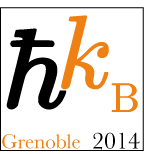In the past years, ground-breaking experiments have been realised in quantum transport in generating single-electronic states [1]. In the experiment of G. Fève et al., the single-electron source consists of a mesoscopic capacitor driven by a gigahertz periodically potential. This leads to a triggered emission of one electron and one hole per period. The controlled emission of single-particle states enables the investigation of fundamental quantum mechanical properties such as the coherence of these single-electron states [2], useful for quantum information purposes, and the realization of fermionic analogues of quantum optics experiments such as the Hanbury-Brown and Twiss and Hong-Ou-Mandel experiments [3].
In this talk, we show that the heat current enables us to gain crucial information about the shape of the single-particle states compared to the charge current. To this end, we investigate the reabsorption effect with two single-electron sources coupled in series [4]. Depending on the frequency of the driving compared to the time spent by the particle inside the cavity, the quantum states are characterised by a Lorentzian envelope in the adiabatic regime and an exponentially decaying one in the non-adiabatic regime. While the charge current nullifies in both regimes, the energy carried by electron-pairs in the non-adiabatic regime is enhanced by a factor 2. We finally discuss the validity of the Joule-Lenz law and the fluctuation-dissipation relation in both regimes, when cavities emit electron-hole pairs and particles of the same kind.
[1] G. Fève et al., Science 316, 1169 (2007); N. Maire et al. , Appl. Phys. Lett. 92, 082112 (2008); J. Dubois et al., Nature 502, 659 (2013).
[2] G. Haack, Phys. Rev. B 84, 081303 (2011); G. Haack et al., Phys. Rev. B 87, 201302 (2013).
[3] E. Bocquillon et al., Phys. Rev. Lett. 108, 196803 (2012); E. Bocquillon et al., Science 339, 1054 (2013).
[4] M. Moskalets et al., Phys. Rev. B 87, 125429 (2013).
- Presentation

 PDF version
PDF version
